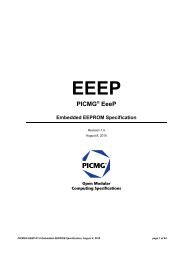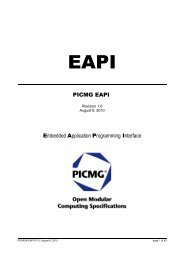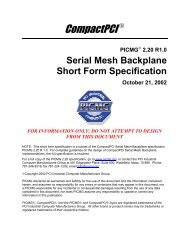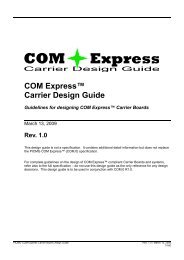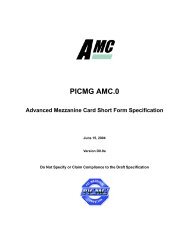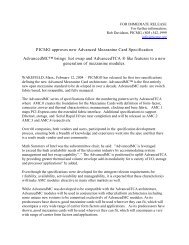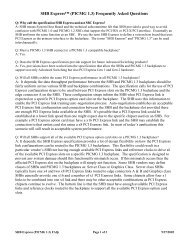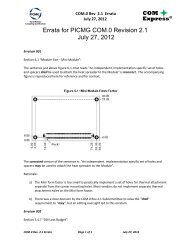PICMG 2.16, CompactPCI Packet Switching Backplane
PICMG 2.16, CompactPCI Packet Switching Backplane
PICMG 2.16, CompactPCI Packet Switching Backplane
Create successful ePaper yourself
Turn your PDF publications into a flip-book with our unique Google optimized e-Paper software.
<strong>PICMG</strong> ® <strong>2.16</strong> R1.0 Short Form Specification<br />
INTRODUCTION<br />
Ethernet network technology continues to be incorporated into more products than ever before.<br />
Once networked, components are relatively easy to integrate, allowing acceleration of system<br />
development.<br />
Existing network technology is naturally bridged by networked components, thus providing<br />
unparalleled system scalability. The continued ability of products to interoperate is essential to<br />
the timely development and evolution of systems in a changing world. Opportunities remain for<br />
improving the rapid integration of products that will continue to adapt to the special needs of the<br />
industry.<br />
The <strong>CompactPCI</strong> <strong>Packet</strong> <strong>Switching</strong> <strong>Backplane</strong> (<strong>CompactPCI</strong>/PSB) is an extension to the <strong>PICMG</strong><br />
2.x family of specifications that overlays a packet-based switching architecture on top of<br />
<strong>CompactPCI</strong> to create an Embedded System Area Network (ESAN). It supplements the robust,<br />
reliable and hot-swap capable <strong>CompactPCI</strong> architecture with the easily integrated, low-cost,<br />
high-performance, and extensible Ethernet. This creates a platform well suited to the integration<br />
of components for the most demanding systems and empowers system integration and design to<br />
ascend to higher layers of the Open Systems Interconnection (OSI) protocol stack, thus reducing<br />
system integration time.<br />
Objectives of the <strong>CompactPCI</strong> <strong>Packet</strong> <strong>Switching</strong> <strong>Backplane</strong><br />
The objective of the <strong>CompactPCI</strong>/PSB Specification is to define an IEEE 802.3-2000<br />
1000BASE-T compliant packet switching backplane to supplement the existing suite of <strong>PICMG</strong><br />
2.x Specifications. This provides designers, manufacturers, and integrators with a common<br />
platform for implementing an ESAN that provides all the benefits of a Local Area Network<br />
(LAN) in an embedded system environment. An ESAN can provide high-availability by<br />
providing redundancy in both interconnections and switching components.<br />
Use of IEEE 802.3-2000 provides an industry-standard framework for network communication<br />
within the chassis that inherently follows the rules set forth in the OSI Reference Model (see<br />
Figure 1). OSI divides network communications processes into seven components called layers.<br />
Every layer consists of protocols for communicating with the preceding and succeeding layers.<br />
The <strong>CompactPCI</strong>/PSB Specification leverages IEEE 802.3-2000 1000BASE-T in providing the<br />
physical and data link layers. Protocol stacks such as TCP/IP can be added at the network and<br />
transport layers to provide a reliable connection-oriented environment.<br />
Application<br />
Presentation<br />
Session<br />
Transport<br />
Network<br />
Data Link<br />
Physical<br />
Figure 1 OSI Reference Model<br />
FOR INFORMATION ONLY;<br />
DO NOT ATTEMPT TO DESIGN FROM THIS DOCUMENT




